Menu
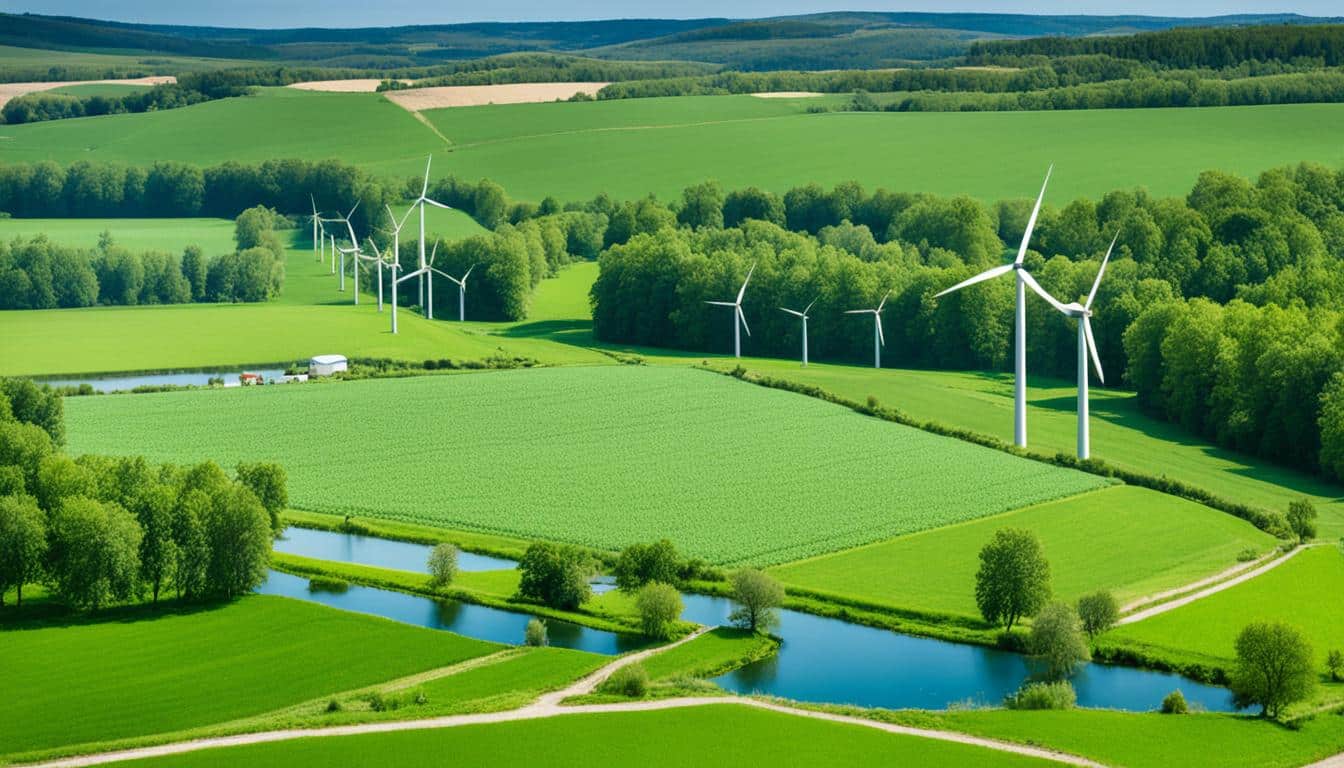
Did you know soil is essential for farmers, helping to grow crops and make money? With the world needing 70% more food by 2050, we must farm sustainably. This way, we protect the planet’s future. Farming contributes a lot to global warming. So, using methods that cut carbon is key.
One great method is carbon farming. It fights climate change and boosts a farmer’s income by storing carbon in the ground. Actions like mixing crops, changing what you plant each season, and working the land less reduces greenhouse gases. They also make the soil healthier, keep chemicals out of the water, and grow more plant and animal life. These ways not only help farms last for the long term but are also crucial for a sustainable, carbon-free future.
By 2050, we must meet 70 percent more global food demand. To do this, we need low carbon farming. It aims to make farming better for the environment. This way, it deals with the 31 percent of greenhouse gases that come from farms. Low carbon farming helps us fight climate change, cuts down on harmful gases, and looks after the land properly.
Low carbon farming, or LCF, is all about farming in a way that’s good for the Earth. It uses special methods to grow food without hurting the environment. These methods include growing different crops together, changing which plants grow in a field each year, and farming on hills in a certain way. Farmers also let their animals eat the grass in a certain pattern and some even avoid ploughing their fields. All this helps to make farming better for the planet. It also means more food, more money for farmers, and a healthier world.
Using Earth-friendly ways to grow food is really important. The food we eat often comes at a cost to the environment. Over half of the harmful greenhouse gases in places like Latin America come from farming. In Brazil, where we get lots of soy from, farming this crop adds to those damaging gases a lot.
2.6 billion people around the world depend on farming for work. We must find ways to farm that don’t harm the planet. This kind of farming is better all around. It helps the Earth, makes sure there’s enough food, and keeps farmers going strong. We need everyone, from governments to companies, to work together on this. Only then, we can really change things for the better.
| Aspect | Current Statistics | Goals |
|---|---|---|
| Global GHG Emissions | 31% from Agriculture | Reduce significantly |
| Food Demand Increase by 2050 | 70% | Meet sustainably |
| Carbon Dioxide Levels | 412.5 ppm (2020) | Stabilise and reduce |
Low carbon farming has many upsides, hitting on the green, cash, and people fronts. It’s key for keeping the earth healthy while keeping food coming. This mix is crucial for our future.
Going climate-smart in farming helps cut down on harmful gas emissions. This is big, since farms add a lot to global emissions. Things like planting trees can clean up water and soil, and smart tech uses resources better.
There’s a lot of money sense in leaning towards low carbon farms. They can boost profits by saving on costs and upping what’s grown. Also, using solar and wind cuts costs and fighting climate change pays more. Farmers can even make money this way, which makes greener farming a real winner.
Low carbon farming helps out millions of farming families around the world. It is their main income, so it’s vital to do right by them. By fighting climate change, food stays safe, and small farms do better against big challenges. Training them to farm smartly secures their future with us.
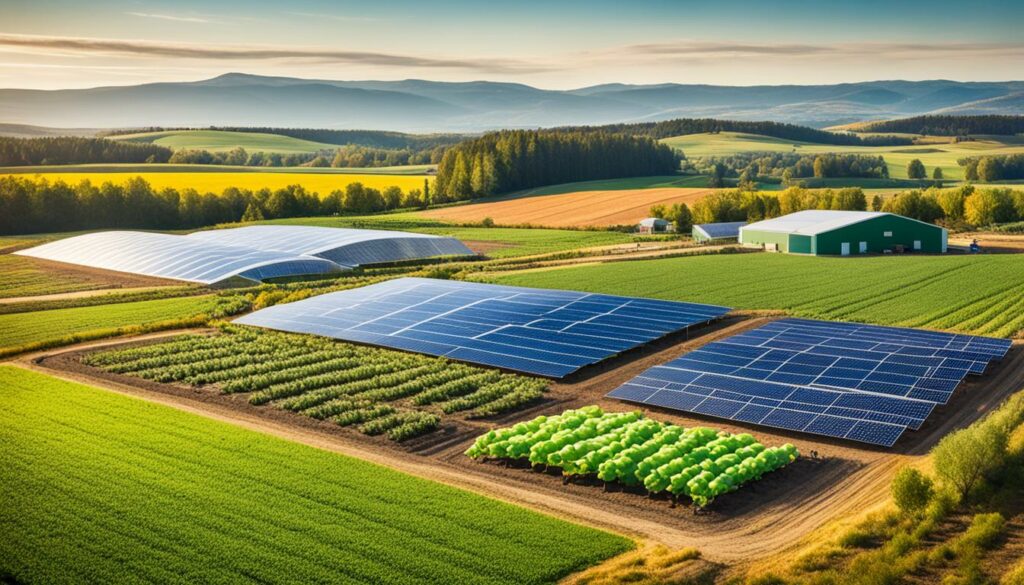
| Environmental Aspect | Contribution |
|---|---|
| GHG Reduction | 24% of global emissions come from agriculture, and sustainable practices help mitigate this. |
| Water Quality | Agroforestry systems improve water quality through better soil management. |
| Renewable Energy | Integration of solar and wind energy reduces carbon footprint. |
Using low carbon farming methods can make ecosystems healthier. It also boosts productivity and keeps the Earth sustainable. These methods help soil get better and increase the variety of life.
Intercropping means you grow different crops close to each other. This boosts the variety of plants and makes farming more effective. It uses resources better, controls pests and diseases, and raises the amount of crops.
Farmers improving their land use with these techniques build a stronger farming system.
With crop rotation, farmers grow different crops in the same place at different times. This helps the soil stay good and stops diseases and pests. It keeps the land producing food for a long time, with crops getting the right nutrients to be strong and healthy.
Not tilling the soil much keeps it healthy and stops it getting eroded. This farming method is friendly to the Earth and helps keep carbon in the soil. This lowers the amount of carbon in the air. It also makes the soil better at holding water, which helps crops grow well.
Choosing these farming ways is a big step towards making farming kinder to the planet. It shows that we can have both productive and eco-friendly farming. This leads to a farm-filled future that’s good for the Earth too.
Agroforestry is a modern way of growing plants. It blends trees with crops and animals, bringing lots of benefits. It makes farming more eco-friendly. The method boosts the variety of life in an area, helps the soil stay healthy, and manages water better. So, it works well for the planet. Also, it lets farmers make money in different ways, which is good for both profit and nature.
Agroforestry mixes trees with crops and shows off good side effects. For example, it helps the earth soak up more carbon and grow food better. Research found that adding phalsa trees to the mix boosted farm productivity a lot. At the same time, the soil became richer.
It’s also a win for the wallet. A farm with Karonda trees, mung beans, and potatoes made the most money, reaching over 3500 US dollars per hectare. It also used water well, showing how these methods are good for the long run. A different set-up with Karonda, cowpeas, and mustard showed that for every unit spent, they got back almost four. This proves they bring in a handsome profit while taking good care of the land.
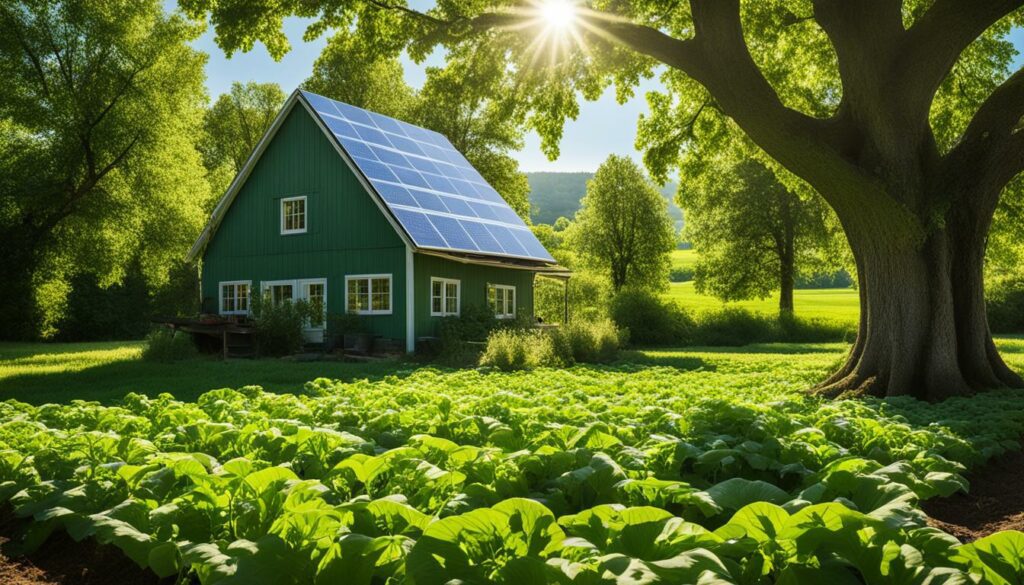
Agroforestry adapts to different places, making it quite flexible. In Brazil, they mix cocoa with bananas and local trees. This layout uses space wisely and brings in money from a range of sources.
In places like the dry site with about 650 mm of rain each year, agroforestry thrives. The land there is good for mixing crops and trees. It shows how this method suits lots of lands, supporting both good farming and saving the environment through smarter agriculture.
| System | Productivity (Mg/ha) | Net Return (US$/ha) | Water Use Efficiency (kg/ha-mm) | Benefit-Cost Ratio | Soil Organic Carbon Density (Mg/ha) |
|---|---|---|---|---|---|
| Phalsa + Mung Bean – Potato | 25.9 | – | 33.0 | – | – |
| Karonda + Mung Bean – Potato | – | 3529.1 | 33.0 | – | – |
| Karonda + Cowpea – Mustard | – | – | – | 3.85 | – |
| Phalsa + Cowpea – Mustard | – | – | – | – | 9.10 |
| Moringa + Mung Bean – Potato | – | – | – | – | 9.16 |
Reducing greenhouse gas emissions in farming is key to fighting climate change. Using smart farming, we can cut down on harm to the environment. This helps to build a future that’s better for everyone.
It’s vital to handle livestock manure well to lessen greenhouse gases. For example, using anaerobic composting can reduce methane. Since methane makes up about 14.5% to 18% of all farm emissions, this is a big deal. It also means farmers can make better use of manure and reduce their greenhouse gas impact.
Making irrigation more efficient is another important step in smart farming. Efficient systems use less energy, so there’s less carbon in the air. Some 15% to 25% of farmers worldwide are already using these sustainable methods. This shows they work well and are easy to use.
| Greenhouse Gas Sources | Percentage of Emissions |
|---|---|
| Agricultural Activities | 14% to 24% |
| Livestock-Related Activities | 14.5% to 18% |
| Sustainable Management Practices | 10% to 15% |
By focusing on manure and irrigation, we can cut greenhouse gases in farming. These efforts are essential worldwide. With everyone working together, we make farming more sustainable. This helps our planet stay healthy for the future.
In the fight against climate change, carbon sequestration in soil is key. It helps store carbon in the soil. This means less carbon dioxide escapes into the air, which is good for the planet. And, it makes the soil healthier for farming.
The importance of carbon sequestration in soil cannot be overstated. Farming has sent 133 billion metric tons of CO2 into the air over 12,000 years. The IPCC says capturing carbon in soil could help avoid 5.3 GtCO2 emissions yearly by 2030. By managing soil well, farms can fight climate change.
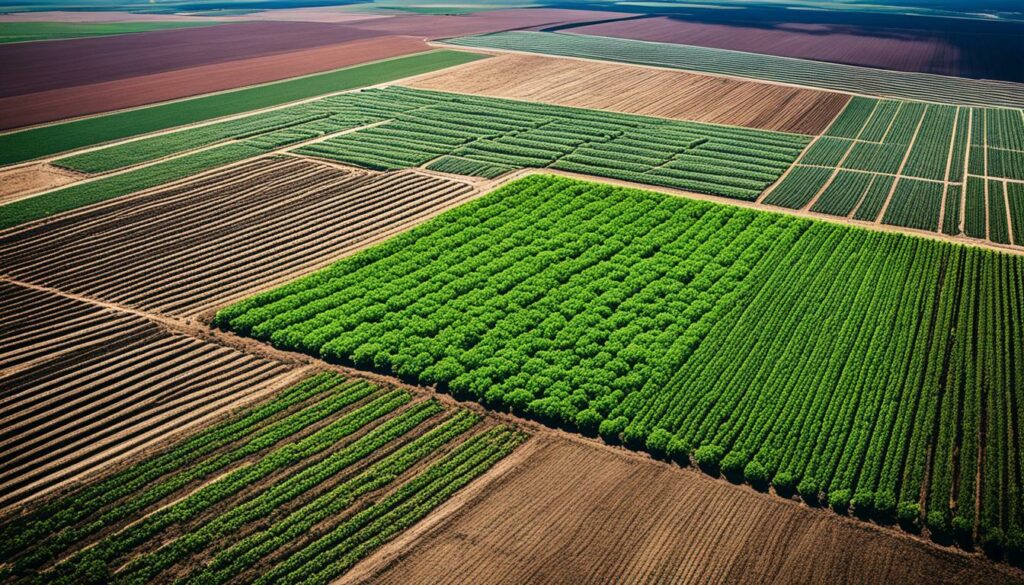
Using the right farming methods can boost soil health and store carbon. For instance, less tilling means keeping more carbon in the soil. This makes the soil better and helps prevent erosion.
Farming practices like using organic fertilizers and managing leftover crops well also help. They make soil more fertile and reduce unwanted chemicals in water.
Planting cover crops, avoiding empty fields, and planting certain plants can also be great. They keep soil fertile, store carbon, and make farms better places for plants and animals. All this helps farmers have more success, save money, and fight climate change.
| Practice | Benefits |
|---|---|
| Reduced Tillage | Preserves soil quality, retains carbon content, benefits crop yields |
| Application of Organic Fertilizers | Optimises nutrient application, reduces chemical leakage |
| Cover Crops | Protects soil, builds fertility, increases soil organic carbon |
| Agroforestry Practices | Increases biodiversity, stores carbon, improves farm productivity |
It’s evident that focusing on carbon sequestration in soil works well for farms and the environment. These efforts improve crop yield, save money, and open up new income chances for farmers. With proper monitoring, reporting, and verification, farmers can earn through carbon markets while helping the planet.
Sustainable land management means using land without damaging it for the future. It balances growing food with looking after the land. It sticks to rules that help keep the land healthy. These rules focus on using natural resources carefully and protecting nature. With ways like conservation farming, the soil stays good for farming, which makes agricultural sustainability better.
It’s very important to follow strong environmental rules. The Amazonia Connect scheme is making big efforts in South America. It’s teaching farmers in places like Brazil, Colombia, and Peru to farm without hurting the environment. This is crucial for the future of farming.
Some facts show why we need to act now. We’ll need to produce 70% more food by 2050 because of more people. But, the food system today is a big cause of pollution. Latin America is particularly a high polluter because of farming and changes to the land. For example, Brazil must lead by using the land wisely as it makes a lot of soybeans.
Over 2.6 billion people rely on farming. This shows we must farm in ways that keep the land and the profit healthy. Agroforestry schemes in places like Côte d’Ivoire, Ghana, Liberia, and Sierra Leone help. They make farming better for the environment. These efforts help in having farms that last long and benefit both the people and the planet.
To sum up, using the land wisely lets us grow food and also protect nature. With everyone’s effort and using smart methods, we can look after our planet. This way, we make sure there are enough resources for farming in the future.
Climate-smart farming is a new way of doing agriculture. It aims to make farming more productive, strong against problems, and better for the planet. Agriculture causes a lot of the world’s pollution and cuts down many trees. These new farming techniques help fight these big issues.
These practices help farms grow more food, stay strong, and make less pollution. They use special farming methods, save water, grow better crops, and use clean energy. The World Bank is now spending almost $3 billion each year to support this kind of farming.
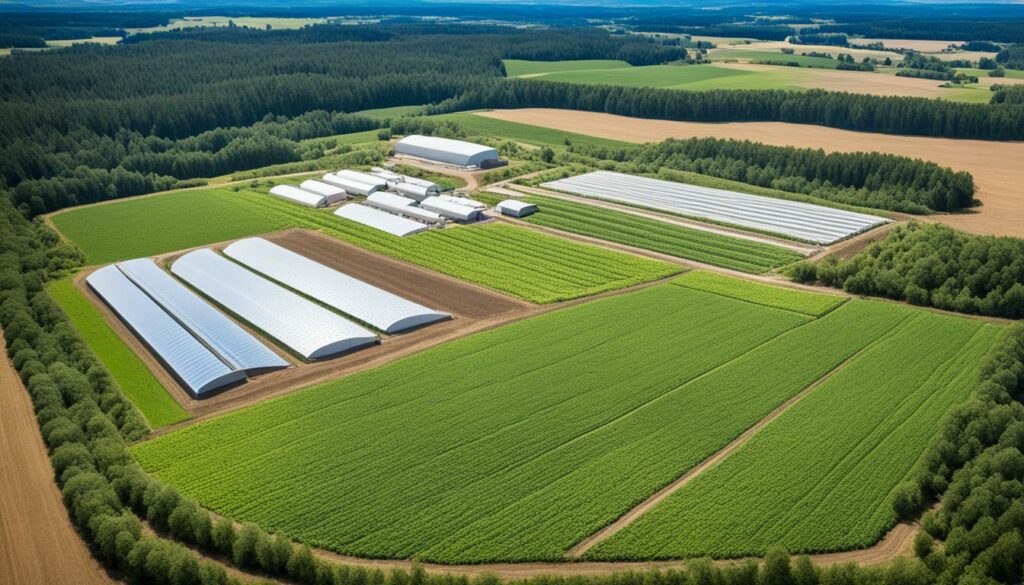
The World Bank’s help is in line with the Paris Agreement’s goals. It’s also supporting special farming plans in places like Bangladesh, Kenya, and Zambia. These plans aim to make agriculture safer for the environment by using strong plants, taking care of the soil, and using resources well.
There are many good examples of these new farming ways across the world. In India, smart farming has helped get more crops and deal with changing climates. In Brazil, farmers grow crops alongside trees that help the environment. This way, they store more carbon and look after different plants and animals.
In Africa, where water is running low, farmers are using their water better to grow crops. This helps save water and makes less pollution. Organizations like CGIAR and the World Bank are behind these new farming methods. They work on things like adding healthy stuff to the soil, not digging too much, and planting different crops. Each thing helps the farm stay healthy and the air clean.
Low carbon farming offers big chances through smart economic rewards. These rewards help farmers move to greener ways, cutting down on harmful gases. They also take better care of the land.
Turning your efforts to save the planet into cash is becoming popular in farming. By selling carbon credits, farmers can earn money. In North America alone, farmers could make about $5.2 billion every year from this.
About 57% of the need for carbon credits comes from the food and drink industry. This pushes farmers to be ‘greener’, fighting climate change. They can earn money through schemes like the ACORN marketplace, encouraging eco-friendly farming.
Small farmers face a lot of financial pressure. The money they gain from eco schemes could boost their income by $30 to $45 for each acre, per year.
In places like Iowa, these schemes could add between $30,000 and $45,000 to their earnings. This cash supports farmers, helping them plant better crops and take care of the soil.
The U.S. Department of Agriculture has big goals for 2050, wanting to cut farming’s carbon output by 40%. By rewarding farmers, the industry can be a major player in the battle against climate change. This also helps keep the farmers financially stable.
These incentives are a win-win. They help make farming more planet-friendly. They also give real financial boosts to farmers, especially the smaller ones. These benefits are important for those who might find it hard to afford changes.
Setting up low carbon farming is tough due to several reasons. Technological limits, financial issues, and policy hurdles stand in the way. It’s key to tackle these to make farming more sustainable.
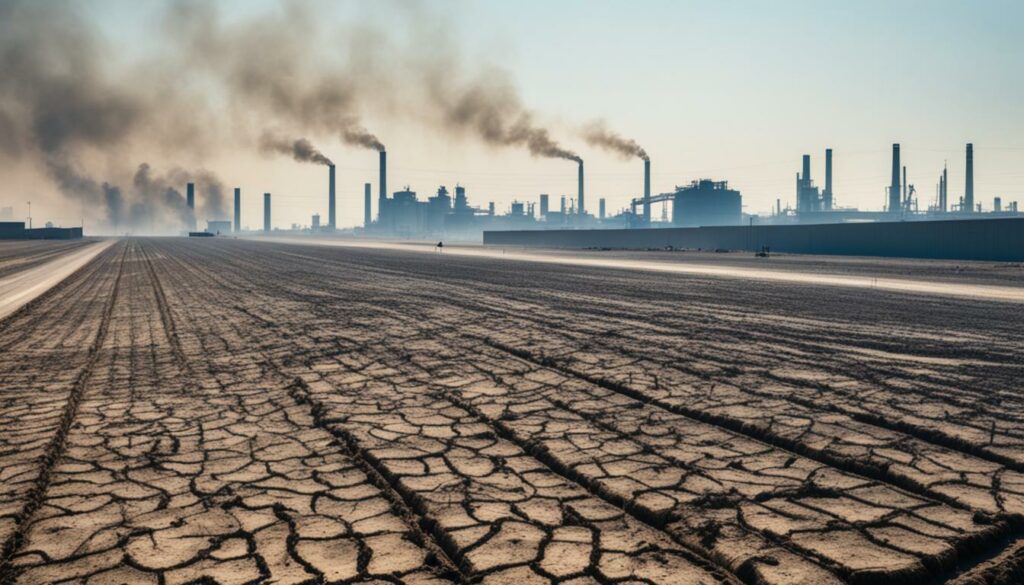
Farmers face a lack of modern tools for low carbon farming. They can’t easily monitor and cut down their emissions. Added to this, the high cost of such tools puts them out of reach for many.
The money side of things also stops farmers from going green. They worry new methods won’t pay off in the long run. The risk of future demand for carbon credits doesn’t help either, especially if it means agreeing to long contracts. Also, getting started often needs a lot of cash and education.
Changing policies make it hard for farmers to change their ways. We need clear, helpful rules and support from governments. But, different rules on how to measure and report emissions confuse everyone. And, the interests of various sectors, like forests and industry, make finding fair policies tough.
Beating these obstacles needs everyone on board. Governments, businesses, and farmers themselves must work together. They need to find answers that help farming thrive while using less carbon.
Looking at low carbon farming shows us how to use less energy and reduce pollution while growing food. The Global Methane Pledge wants to cut 30% of the world’s methane gases by 2030. It looks to green ways of farming and new tech to do this.
In the UK, farming makes 10% of all the country’s pollution. But, by using new tools, farmers can make a big difference. For example, there’s Bovaer for cows, cutting down their bad gases by 30%. Also, Zelp’s masks help reduce cow farts by over half. These show that mixing new ideas with old ones can really work.
Over in Western Australia, the CF-LRP is spending $15 million to make farming more planet-friendly. They’re planting trees and improving the soil to soak up lots of harmful CO2. The Dirty Clean Food project plans to plant trees and grab 39,567 ACCUs to fight climate change.
In the UK, the Lemonade Valley project is also working hard to help the earth. They’re replanting trees, fixing habitats, and making soils better on 200 hectares. This will get them 29,164 ACCUs, making their farm greener. Plus, the Red Gully Farm project aims to trap a huge amount of carbon in the soil. On 975 hectares, they’re planning to save 99,136 ACCUs, protecting the earth’s future.
Years ago, the world had 280 ppm of CO2. But now, it’s at 412.5 ppm. This is a big red flag to farm in smarter, cleaner ways. Learning from these examples, we can make our farms kinder to the earth. This not only cuts down harmful gas but also helps our planet to be healthier.
Low carbon farming methods change based on local needs and environments. They show that farming in an eco-friendly way is possible. This is key for our planet’s future.
Brazil leads in using eco-friendly farm methods due to its large farming areas. The ABC+ Plan there is spreading low carbon techs on 72.6 million hectares. This could cut up to 1 billion tons of CO2 equivalent.
This push puts trees, crops, and animals together to make farming better for nature. Amazonia Connect is helping in this for five years in Brazil, Colombia, and Peru.
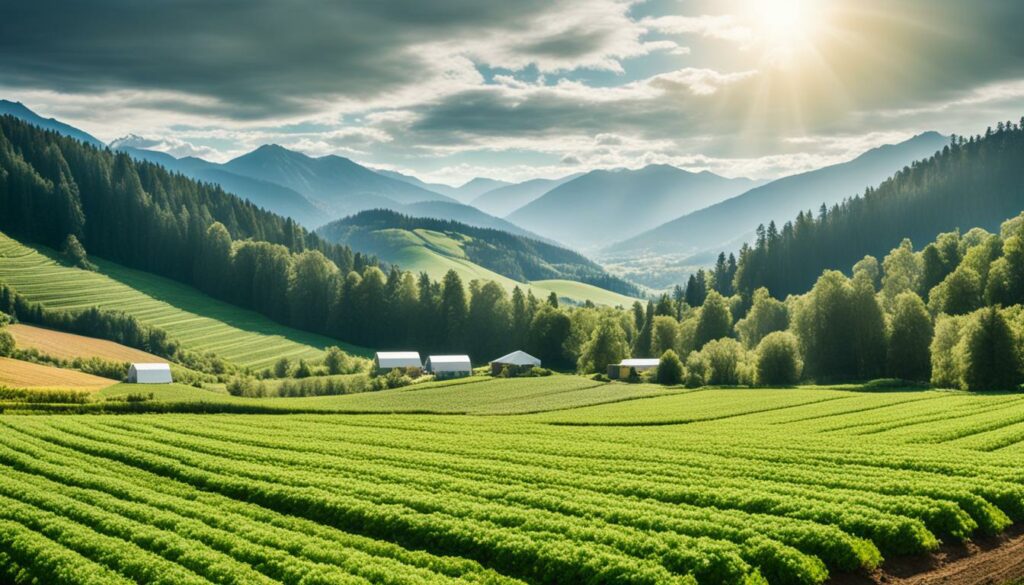
India is adopting green farming to produce more food and less emissions. Mixing crops and using smart irrigation and solar power helps. These steps are vital in a country where many depend on farming for life.
Sustainable methods are changing farming in Côte d’Ivoire. The work there and in Ghana, Liberia, and Sierra Leone is big. Over 148,000 farmers are using better ways on almost 179,000 hectares of cocoa farms.
Adding trees to cocoa farms not only helps the crops but also the environment. It makes farming last longer, matching global low carbon targets.
New technologies and innovations are changing the face of low carbon farming. They’re guiding us to a more sustainable farm future. These breakthroughs make farming more efficient, sustainable, and cut down our carbon footprint.
Precision agriculture is a big leap in farming techniques. It uses GPS, sensors, and robots to perfect planting, fertilising, and watering. This doesn’t just boost crop yields but also slashes waste and harm to the environment. Advanced irrigation systems save water and keep plants healthy, which is vital in dry areas.
Farmers now rely on carbon estimation tools too. These tools measure greenhouse gases like N2O, CH4, and CO2, letting farmers watch their carbon output. Keeping track of these emissions helps farmers go greener. They might even earn money by selling saved carbon on the carbon market.
Big data is changing farming for the better. It helps farmers choose better and boost their farms’ productivity and strength. Getting real-time data from soil, weather, and satellites gives farmers exact info. They can make changes that fit their crops’ needs exactly.
Using AI and machine learning in farming systems improves how decisions are made. This makes farming smarter and less of a hit-and-miss. It means better predictions on trends, pest attacks, and using resources better.
Scaling up sustainable farming needs both public and private help. We must make positive policies, give good rewards, and teach well to spread low carbon farming methods. Efforts like Amazonia Connect show how different groups can work together for greener farming. They show real steps we can take to make farming less of a burden on the earth.
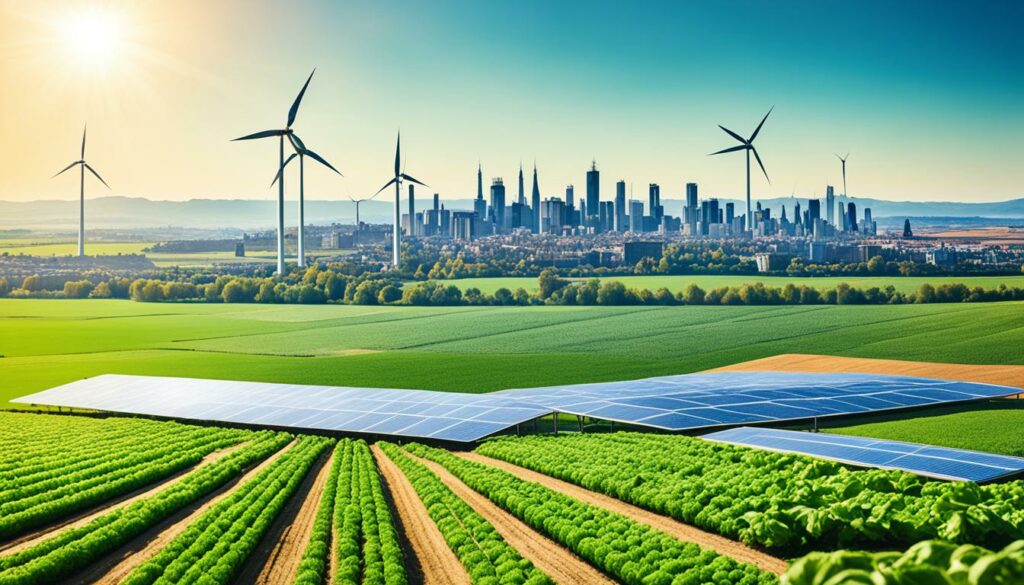
About 31% of the world’s man-made greenhouse gases come from food and farming. This includes direct farm emissions, changes in land use, and food processing. In places like Latin America and the Caribbean, more than half of these emissions come from how we use land and farm. It’s clear we need to do more to farm in ways that are better for our planet.
Using agroforestry is a big part of making farming more eco-friendly. In the Amazon region, adding trees to coffee farms in Colombia helps protect wildlife and fight the climate crisis. In West Africa, a cocoa project has seen over 148,000 farmers look after their land better. This has helped across nearly 179,000 hectares of cocoa farms. These are important steps towards a farming future that’s kinder to the environment.
Greener farming could help us get ready for a big increase in the food we need by 2050. For example, the LIFE Carbon Farming project in Europe plans to cut greenhouse gases by 15% on 700 farms in six countries by 2027. This shows that these projects can really make a difference.
| Region | Specific Initiative | Impact |
|---|---|---|
| Amazon | Agroforestry in Colombia | Enhanced biodiversity and climate resilience |
| Côte d’Ivoire, Ghana, Liberia, Sierra Leone | Cocoa program | Responsible farming on 179,000 hectares |
| European Union | LIFE Carbon Farming project | 15% reduction in carbon footprint by 2027 |
Efforts such as the European Regional Development Fund’s initiative and projects funded by €2 billion from the CBE JU show a strong push towards greener farming. By backing such projects, we set the stage for more widespread and effective eco-friendly farming. This way, we ensure a farming future that’s good for nature and for our economy.
Green agriculture’s journey brings us to low carbon techniques that are key for our future. These methods can take a huge amount of carbon from the air. This cuts down global warming. Plus, they could boost the economy by giving Americans billions of dollars. But, moving to these ways has a lot of challenges.
One big issue is if carbon stored in the soil can stay there. Stopping green practices might release this stored carbon back into the air. To make a real difference, we must make sure these efforts to store carbon are honest, not just for money. We need to look out for issues where moving plants or animals around doesn’t truly lock away carbon.
To make a real market for carbon storage, we need to measure soil carbon equally. Even making this fair for all farmers is hard. Some farmers might see their benefits decrease over time. Also, what’s good for the soil might mean more pesticides. And we can’t forget how big of a role gases like methane and nitrous oxides play in making Earth warmer.
In Central Europe, countries like Poland are making big strides in green farming. They are focusing on smarter animal food, less waste, fewer chemicals, and better fertilizers. With the right national plans and money, they aim to meet the Paris Agreement. By working together and using new ideas, we can make farming a leader in fighting climate change.
Low carbon farming aims to improve food security and adapt to climate change. It does this by cutting down on greenhouse gas emissions. This way of farming helps meet global climate goals.
They help limit climate change impacts and protect food supplies. Especially for small farmers hit hard by environmental shifts.
Low carbon farming cuts on-farm greenhouse gases and boosts soil health. It also helps keep our water clean and protects wildlife.
It can bring in more money for farmers through higher yields and savings. Plus, they can earn extra selling carbon credits.
It improves food safety and helps communities handle climate change. It also creates jobs that protect the environment.
It’s growing different crops together in one field. This boosts biodiversity and helps the soil and crops thrive.
It helps keep soil healthy, fights pests, and uses nutrients better. All this leads to ongoing farming success.
This method keeps soil strong, stops it from washing away, and stores more carbon. It’s key for lasting soil health.
It pairs trees with crops and animals for a healthier farm. It boosts biodiversity and provides extra income from tree products.
By managing manure well, turning waste into energy, and using water wisely. These steps cut down on farming’s carbon.